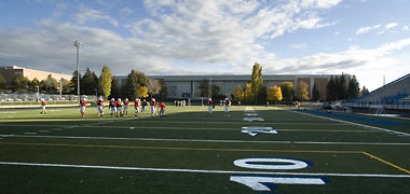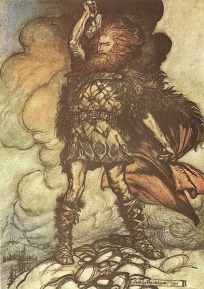The Graduate's Grind: Brigham Young University- Idaho
The Proud Viking
By. Laura Arrington

Anyone who’s walked the hall of the Hart, or walked between the impressive building and the stadium and looked into the upstairs window has probably seen the statue of the Viking deity Thor. Ricks College, before the change to BYU-Idaho, was represented in college sports as the Vikings, and even now the Vikings are still a part of our intramural sports. The Viking statue standing in the hallway of the Hart was unveiled as a gift in 1988 during the Centennial celebration of the college, and continues to remind us of the athletes who came before.
The Vikings were Norse people that traveled the seas, raiding and settling other lands along the European coast. Words associated with this people included barbarians, pirates, and savages. Thor was the god of Thunder and was the essence of these warriors. He was a strong fighter, and although he was not the leader of the gods, more mythology is written of him, and he was prayed to more than any of the others gods. Their culture was based around battle and conquest, and they strove to reach Valhalla, the heaven for warriors. They staged fights, and it was their greatest desire to die on the battlefield. It is somewhat ironic that these warriors, these bloodthirsty warmongers, are what were chosen as the mascot for the student athletes of a church college.
From 1919 to 2000, Ricks College was among the schools that competed throughout the country. The Viking was chosen in 1934 as the school mascot. As Vikings, the teams of Ricks College banded together to win the “battles” on the sports field, cheered on by the many students who were fired up by the spirit of the fierce Viking. That spirit, the one that preceded and is a direct ancestor of the much gentler Spirit of Ricks, raged through the campus for many years with one student reporting in the Viking Scroll: "Vikings---that's what we are or are trying to become. It is courage that makes the team put up a strong fight in the face of terrific opposition; it is the loyalty to the ideals set up and maintained by former students; it is the development of character in the participation in music, debating, or dramatics. Those who get the most out of the school are those who have the courage, the loyalty, the strength of character, the determination to be real Vikings!"
The Vikings were Norse people that traveled the seas, raiding and settling other lands along the European coast. Words associated with this people included barbarians, pirates, and savages. Thor was the god of Thunder and was the essence of these warriors. He was a strong fighter, and although he was not the leader of the gods, more mythology is written of him, and he was prayed to more than any of the others gods. Their culture was based around battle and conquest, and they strove to reach Valhalla, the heaven for warriors. They staged fights, and it was their greatest desire to die on the battlefield. It is somewhat ironic that these warriors, these bloodthirsty warmongers, are what were chosen as the mascot for the student athletes of a church college.
From 1919 to 2000, Ricks College was among the schools that competed throughout the country. The Viking was chosen in 1934 as the school mascot. As Vikings, the teams of Ricks College banded together to win the “battles” on the sports field, cheered on by the many students who were fired up by the spirit of the fierce Viking. That spirit, the one that preceded and is a direct ancestor of the much gentler Spirit of Ricks, raged through the campus for many years with one student reporting in the Viking Scroll: "Vikings---that's what we are or are trying to become. It is courage that makes the team put up a strong fight in the face of terrific opposition; it is the loyalty to the ideals set up and maintained by former students; it is the development of character in the participation in music, debating, or dramatics. Those who get the most out of the school are those who have the courage, the loyalty, the strength of character, the determination to be real Vikings!"

In 2002, during the final year of intercollegiate sports, the Vikings had major success in their games, including when “The Vikings tromped previously undefeated Lackawanna College of Scranton, Penn., 49-21. Final NJCAA ranking, #5” (Poulter). Overall, the Ricks College Vikings “earn[ed] 17 national titles, 61 individual national titles, and producing nearly 100 first-team All-Americans” (“Commencement”).
As of June 2000, it was announced that the athletics program would be changed to an intramural program. President Gordon B. Hinckley of the 1st Presidency of the Church of Jesus Christ of Latter-day Saints gave the reason in a commencement speech in 2002. He said, “We determined that we would have to give up intercollegiate athletics. They are so costly” (“Commencement”). Cost was the biggest factor in the change, but a lot of good came out of the change to intramural teams. Now, instead of just a handful of students getting to participate in sports, all who want to can join a team and play. It’s something that couldn’t happen if the school had continued intercollegiate sports instead of the new system it has adopted. The Viking still stands as a cornerstone of the sports program here at BYU-I, as the intramural teams continue to bear the Viking name. With such a rich history behind the Rick’s College athletes, is it any surprise that they kept it around?
As of June 2000, it was announced that the athletics program would be changed to an intramural program. President Gordon B. Hinckley of the 1st Presidency of the Church of Jesus Christ of Latter-day Saints gave the reason in a commencement speech in 2002. He said, “We determined that we would have to give up intercollegiate athletics. They are so costly” (“Commencement”). Cost was the biggest factor in the change, but a lot of good came out of the change to intramural teams. Now, instead of just a handful of students getting to participate in sports, all who want to can join a team and play. It’s something that couldn’t happen if the school had continued intercollegiate sports instead of the new system it has adopted. The Viking still stands as a cornerstone of the sports program here at BYU-I, as the intramural teams continue to bear the Viking name. With such a rich history behind the Rick’s College athletes, is it any surprise that they kept it around?
